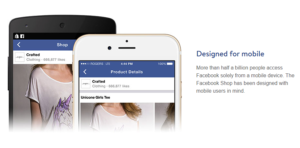Today’s contribution comes from Patrick Foster, an ecommerce consultant and writer at ecommercetips.org.
We are already into the third month of Q1 2017 – gasp. And there are a lot of emerging ecommerce marketing trends you should be considering as part of your strategy. Building and defining a loyal customer base is critical to the success of your ecommerce brand, and keeping up with the latest trends in communication methods can be tedious. With so many channels, platforms and content types – how can you ensure your marketing is personal and effective? Here is the first blog of our content series looking at ecommerce marketing and personalization in 17/18.
Ecommerce marketing in 2017 is not just personalized, it’s personal; competition is hot, and creating an emotional connection is critical to success. We’re going to look at the most people-centric marketing techniques of 2017 and introduce some new concepts that might challenge your idea of what ecommerce marketing is capable of.
Email is in vogue
Before we get into the really crazy stuff, let’s not forget the humble, yet effective email. You heard it here first kids — email is back in vogue.
It’s always been there, doing its job and not taking much of the limelight. And despite suffering through somewhat of a dark period of black hat tactics like spamming and phishing, the simple yet effective email has redeemed itself.
There are such a huge range of CRM systems and specialist email platforms on the market, such as Infusionsoft – that there really isn’t any excuse not to be collecting your customer’s basic contact details, and communicating with them regularly. A streamlined CRM system is the first step toward making your online data work for you. It will save you time, effort and hassle and you’ll be able to make much more granular decisions based on the conversations you have with your customers.
Email is a really simple and often underrated way to offer added value during the purchase journey of your customer.
Actionable data and AI
Big data, the IOT (Internet of Things), targeting, re-targeting, tracking, advertising and cookies: it’s all ecommerce marketing – and it’s all based on data analysis.
Collecting data on your customers and your site are crucial for your brand; but what is data if it can’t be actioned and properly deployed? It’s nothing but a useless bunch of names and numbers. In 2017, data is about helping brands get even more personal with and closer to consumers.
Marketing is driven by data — this isn’t a new concept. But with more connected users and devices globally, data is driving advanced personalized marketing and advertising. The IOT is making it possible for ecommerce brands to learn about customers in real-time, and send marketing instantly to consumers in the right place at the right time.
Smart devices, AI and Wi-Fi connected gadgets can read data in a room, from temperature to light, and pass it on to other connected devices. The IOT has gone well beyond personal to the point where our tech is making choices for us. For marketers, harnessing the data and using it in the right way is going to be the real challenge.
Facebook and social shopping
Have you noticed the little shop front icon on your Facebook page? That’s Facebook Marketplace. Relaunched in 2016, Marketplace connects users in your locality with items for sale. The feature makes product suggestions based on search history and other data that Facebook collects from your personal profile.
Marketplace is yet to achieve any impressive milestones, but that’s not to say social media hasn’t already begun to change the way we buy and sell online. Peer to peer recommendations, product shares, page likes, Facebook advertising, in-stream video advertising, Instagram advertising: the list goes on. And brands are loving it. But being in front of your audience when they want to research products or make purchases is key.
There are a number of out-of-the-box website solutions you can either purchase, or use for free, to set up your ecommerce brand. Great. But not only can you sell via your integrated website, you can now sell directly through native applications. As audiences walk around or sit at their desks constantly connected to brands via their mobile devices, it makes sense their shopping habits should shift there too. To be in front of your audience and have a personal connection with them, join the native-revolution of engaged ecommerce brands who are connecting via social channels and apps.
Pinterest’s buyable pins are driving ecommerce sales founded on a deep understanding of visual content, where selling and social stories become almost unrecognizable. But it’s not just the social channels muscling in on online sales, even the big ecommerce brands are ‘going native’; Shopify’s integrated Facebook store allows subscribers to reach their audience, via – you guessed it, Facebook. The Shopify integration allows customers to buy and track orders through messenger – another interesting development in conversational commerce.
You now have the opportunity as an ecommerce business to integrate with native applications via standalone ecommerce platforms and with social media platforms’ own marketplaces. Which one will prevail as the most popular for audiences is something to keep an eye on, and to conduct brand strategy conversations around.
Native developers and brands are coming together to make ecommerce simpler for the consumer, and much more highly targeted. Brands will have to decide whether to leverage the opportunity of selling directly to customers via native platforms, or put their efforts into keeping them on site, where the data is, and leverage that data to increase revenue.
Some of these personal marketing tactics, especially AI influenced, are still a little too close to home for some of us, but it’s interesting and exciting to think what the not too distant future of ecommerce will look like. Ecommerce marketing is a dynamic mix of getting the most out of tried and tested methods like email, and exploring new ground like AI. Whatever you do, make sure that you focus on bringing in customers; keep evaluating your marketing ROI. Read on in blog number two!







AI is the trend, which interests me the most. There’re so many interesting uses for it! Email won’t get out of use anytime soon. Especially now that it’s an essential part of promotions or even marketing automation. GetResponse is also a nice alternative to Inufiusionsoft.
Thanks for reading Jen!